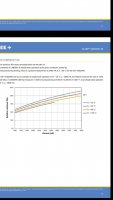Sorry to be the buzzkill mate, but those efficacy levels are based on the calculated efficacy for 25
° C junction temperature AKA not achieveable in practical application.
At 85
° C the efficacy for the CXB3590 DB bin @1,4A (34V) is 165 lm/w, at 55
° C the efficacy is a bit higher, but I seriously doubt you'll be able to get them down to 55
° C @1,4A without active cooling.
Did you do some 3000K vs. 5000K comparison grows? I would be very interested in seeing some data from such grows

I think you should check out the H inFlux strips if you haven't already
 H inFlux | SAMSUNG LED
https://www.digikey.com/products/en?FV=ffecf8a8
H inFlux | SAMSUNG LED
https://www.digikey.com/products/en?FV=ffecf8a8
Ahh OK so the price is the same, but the USD is high contra the CAD at the moment so you feel like you get less for your money?
I mean it would be a much higher Pesos number in Mexico but the price is the same, right? Am I missing some North American thing here?
A 260 might be able to veg 5x5, but not at all efficiently, the PPFD would be negative in the corners

The 260 is only like 60cm long, half the lenght of you tent, but if you get 2x 135 you can center each over a 2x2 area, 3x 135 would kill it in that area.
You can get a board + heatsink combo from Ateum Lighting for 75 USD, then you need a driver, some wire and a few connectors, should stay under 300 USD for two of those

...and MH is very lucky to have Sara here as a rep!...for nearly 6 years, she has been nothing but great for the company...both in promotion and absorbing criticism...sometimes warranted...often not!...if I ever make it to China(prolly not the best idea right now...
) I'll buy her a beer/saki...
...cheerz...h00k...
...












 ...thank you both for the response's...
...thank you both for the response's...

 ), but I now prefer frugal!
), but I now prefer frugal!
 ...lolool...got a couple months before I fire up the 2019 grow, and will be processing info towards better lighting...cheerz...h00k...
...lolool...got a couple months before I fire up the 2019 grow, and will be processing info towards better lighting...cheerz...h00k...
 ...cheerz...h00k...
...cheerz...h00k...